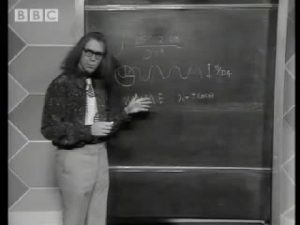50 objects for 50 years. No 9. Tied to the past
Almost constantly the OU has been under the microscope. Its roles and its form have been subject to attention, as has the continuing relevance of its mission. Its staff, or at least its ‘TV Dons’, to employ the term favoured by the popular press, have also been scrutinised.
Since its start the OUhas been associated both with the modernity of television broadcasts and with old-fashioned evening classes and references to night school. The attire of male presenters exemplifies this dichotomy. On the one hand ties indicated respectability, a yearning for a lost world of known sensibilities and order. On the other hand, some of the gaudier versions hinted that a challenge was being made to conventions of taste, that this university was frighteningly hip to the beat. As confidence grew, so ties were on tv discarded.

After a few years of sober neckware Arthur Marwick started to sport, I think that is the best word, cravats.
 The OU was cast into the mould of the 1970s and 1980s and has found it hard to escape. Creating a new image, renewing the brand, has not been aided by internal jokes which have bolstered the clichés. This Faculty Emergency Neckware Resource Centre, complete with half-a-dozen ties behind glass and a small hammer, suggests that men dominated the faculty, that the Dean of that faculty, Mike Pentz enjoyed the same status as Jennie Lee, one of the OU’s founders, and that there were at least six separate occasions when staff might be required to appear in ties but that the rest of the time, stained lab coats, worn corduroy trousers and sandals worn with socks were the norm. The OU module ‘Coaching for performance‘ BG023 tells prospective students that ‘After completing this course you will have[…] used the ‘kipper tie’ model and coaching principle and tool’.
The OU was cast into the mould of the 1970s and 1980s and has found it hard to escape. Creating a new image, renewing the brand, has not been aided by internal jokes which have bolstered the clichés. This Faculty Emergency Neckware Resource Centre, complete with half-a-dozen ties behind glass and a small hammer, suggests that men dominated the faculty, that the Dean of that faculty, Mike Pentz enjoyed the same status as Jennie Lee, one of the OU’s founders, and that there were at least six separate occasions when staff might be required to appear in ties but that the rest of the time, stained lab coats, worn corduroy trousers and sandals worn with socks were the norm. The OU module ‘Coaching for performance‘ BG023 tells prospective students that ‘After completing this course you will have[…] used the ‘kipper tie’ model and coaching principle and tool’.

In 1997 the Independent referred to ‘bearded men in kipper ties talking earnestly about equilateral triangles or soil erosion, flanked by equation-scrawled white boards. The image has secured an affectionate place in the nation’s folklore – ever-present, yet eternally out of date’. In 2001 one OU academic called kipper ties ‘the hallmark of what our University stood for’. By 2003 the association was so close that the Guardian could run an article on the Open University under the title ‘Bye-bye kipper tie’ and expect readers to understand the allusion. In 2005 The Scotsman reported that the OU was trying to ‘sex up’ its image. It then reminded readers that for ‘years, Open University television was associated with bearded professors sporting kipper ties and wild hair explaining complex chemistry theories in the early hours’. In 2006 the Times Higher ran an article about the last OU BBC broadcast made as part of its teaching materials under the headline ‘Goodbye to kipper ties and sideburns’.
Here is Hugh Laurie from the series which ran 1987-95, A Bit of Fry and Laurie mocking OU scientists’ broadcasting on the BBC.

With a symbolic boundary marker separating head and torso as this week’s object, we are reminded of the division between mind and body, so often associated with universities. The artificiality of that divide is perhaps foregrounded and mocked by the more outrageously colourful versions. The OU can be in your head, in your heart and on your screen. We are also reminded that this was the university which reached into people’s living rooms and set a whole nation thinking. Sadly, it might have not been ‘That was an inspirational lesson in level 3 physics’ but ‘What was he wearing round his neck?’